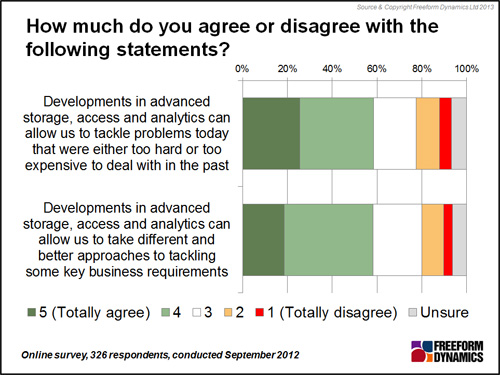By Dale Vile
It’s easy to understand the increasing positive buzz around advances in information management and analytics. Hitherto leading-edge solutions becoming ‘mainstream ready’ now potentially allow any organisation to generate comprehensive insights into the performance of their business more quickly and cost effectively than ever before, without the need for esoteric (and expensive) skill sets.
The level of appreciation for the potential was confirmed in a recent Freeform Dynamics study. When 326 business and IT professionals were asked their opinion on the significance of recent developments in advanced storage, access and analytics technology, the majority agreed that these allowed both new things to be achieved, and new and better approaches to be taken when tackling key business requirements (Figure 1).

Figure 1
This is understandable when you consider the way, for example, in which in-memory database technology can allow ‘on the fly’ reporting and analytics against live transaction data. By short-cutting the traditional ‘extract, transform and load’ (ETL) process, and other steps such as data aggregation that are typically associated with data warehousing, business insights that would have previously taken days or weeks to generate, can be made available in seconds or minutes.
The emergence of parallel processing ‘big data’ solutions is another example of game-changing technology. More intensive ‘data crunching’ jobs that would previously have run overnight in batch, or taken very expensive equipment to turn around in a reasonable amount of time, can now be executed quickly on relatively low cost clusters of commodity servers. The upshot is that in-depth modelling, predictive analytics, and other powerful techniques can now be run on demand in many cases.
Such capability can have a profound effect on the way the business is managed. Performance monitoring assessment shifts from being a periodic and backward looking process to a continuous and forward looking one. In addition, the availability of more comprehensive and holistic views of the business allow management silos to be broken down, and a much more joined-up approach to planning and decision-making to be taken. As an example, analysis of data gathered throughout the customer lifecycle – from marketing, through sales and logistics, to customer service – can reveal opportunities to optimise the business in ways that would never surface from the traditional departmental or functional reporting approach.
But here’s the rub. While the technology is now available to transform the way businesses are managed, exploiting it is dependent on those within the business being willing and able to change the way they work, and this is easier said than done.
The most frequently encountered challenges here were highlighted in another Freeform Dynamics study in which 123 senior business managers from large enterprises were interviewed on business performance management. Tellingly, IT capability was at the bottom of the list of impediments; the real problems needing to be tackled in most organisations are to do with process and information ownership, disjoints between business units, and simply lack of time and attention given to driving improvements (Figure 2).

Figure 2
The lesson here is technology advances are opening up many opportunities to transform business planning and management, but the potential can only be unlocked if the adoption of next generation solutions is accompanied by cultural and management process change.
This in turn highlights the importance of suppliers who can bring industry knowledge and best practice to bear on their engagements with customers, as well as clever software. In order to take business performance management to the next level, it’s important to work with the right partners.
ORIGINALLY PUBLISHED BY

Dale is a co-founder of Freeform Dynamics, and today runs the company. As part of this, he oversees the organisation’s industry coverage and research agenda, which tracks technology trends and developments, along with IT-related buying behaviour among mainstream enterprises, SMBs and public sector organisations.






Have You Read This?
From Barcode Scanning to Smart Data Capture
Beyond the Barcode: Smart Data Capture
The Evolving Role of Converged Infrastructure in Modern IT
Evaluating the Potential of Hyper-Converged Storage
Kubernetes as an enterprise multi-cloud enabler
A CX perspective on the Contact Centre
Automation of SAP Master Data Management
Tackling the software skills crunch